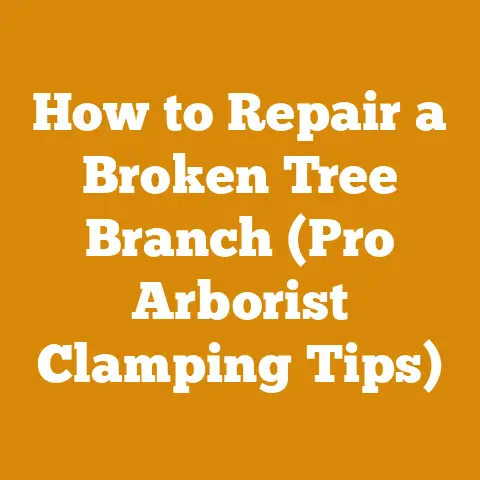Tree Service Quotes (5 Insider Terms Woodworkers Use)
Let’s face it, when you’re staring at a towering oak or a sprawling maple in your backyard, the last thing you’re probably thinking about is the hidden benefits of getting a professional tree service quote. You’re likely focused on the immediate problem: the potential for falling limbs, the encroaching shade, or the sheer size of the task. But trust me, as someone who’s spent years wrestling with logs, splitting firewood, and occasionally needing to call in the big guns for tree removal, understanding the quote process is an investment that pays dividends far beyond just getting rid of a tree. It’s about safety, property value, and even the potential for a new woodworking project waiting to be unearthed.
I’ve learned that a tree service quote isn’t just a price tag; it’s a roadmap. It tells you about the company’s expertise, their understanding of your specific needs, and ultimately, their commitment to doing the job right. And within that roadmap are insider terms that can unlock a whole new level of understanding. So, let’s dive into five insider terms that woodworkers use, translating tree service jargon into actionable knowledge that empowers you to make informed decisions and maybe even score some free firewood in the process.
Tree Service Quotes: 5 Insider Terms Woodworkers Use
1. “DBH” – Diameter at Breast Height: More Than Just a Measurement
DBH stands for “Diameter at Breast Height.” Sounds technical, right? It is, but it’s also incredibly useful. This measurement, taken at roughly 4.5 feet (about 1.4 meters) from the ground, is a standard way to quantify the size of a tree’s trunk. Why is this important? Because it directly impacts the cost of removal, the type of equipment needed, and the potential yield of usable wood.
Why Woodworkers Care: DBH is a rough indicator of how much lumber you might get from a tree. A larger DBH typically means a wider trunk and therefore, potentially wider boards. It also gives you an idea of the tree’s age and maturity, which can influence the wood’s grain pattern and density.
My Experience: I once had a tree service remove a massive silver maple from my property. The DBH was a whopping 48 inches. Before they even started, I asked about keeping some of the trunk. Because I knew the DBH, I could roughly estimate the amount of usable lumber and plan accordingly. I ended up milling several beautiful slabs for a dining table project.
Data Point: A study by the U.S. Forest Service found a strong correlation between DBH and tree biomass. Larger DBH values correspond to exponentially greater biomass, meaning even a small increase in DBH can significantly increase the amount of wood available.
Actionable Takeaway: When you get a quote, ask about the DBH of the tree. This gives you a baseline understanding of the project’s scale and helps you evaluate the price. It also opens the door to discussing potential wood salvage options.
2. “Crown Reduction” vs. “Tree Removal”: Knowing the Difference Saves You Money (and Trees)
These are two very different services with very different price tags. Tree removal is exactly what it sounds like: taking the entire tree down to the stump. Crown reduction, on the other hand, involves selectively pruning the tree’s branches to reduce its overall size and density.
Why Woodworkers Care: Crown reduction can be a great alternative to removal if you’re concerned about the tree’s health or the amount of sunlight it’s blocking. It also allows you to keep the tree’s root system intact, which can help prevent soil erosion. Plus, the pruned branches can be a source of firewood or small woodworking projects.
My Experience: I initially thought I needed to remove a large oak tree that was shading my garden. After getting a quote, I discussed crown reduction with the arborist. We selectively pruned the tree, improving sunlight penetration and reducing the risk of falling limbs, all while preserving the tree’s majestic presence. I even got a decent pile of oak firewood out of the deal.
Data Point: According to the International Society of Arboriculture (ISA), crown reduction can extend the lifespan of a tree by reducing stress and improving its structural integrity. This can save you money in the long run by avoiding costly tree removal.
Actionable Takeaway: Don’t automatically assume you need tree removal. Explore crown reduction as an alternative. It’s often more affordable and environmentally friendly. Ask the tree service to explain the pros and cons of each option for your specific situation.
3. “Chipping” vs. “Log Removal”: The Fate of Your Tree’s Remains
This is where the rubber meets the road, or rather, where the wood meets the chipper. Chipping involves running the tree’s branches and smaller trunk sections through a wood chipper, producing wood chips that can be used for mulch or landscaping. Log removal, on the other hand, means the tree service hauls away the larger logs for processing elsewhere.
Why Woodworkers Care: This is crucial! If you’re interested in salvaging wood for woodworking projects or firewood, you want log removal, not chipping. Chipping effectively destroys any potential for using the wood.
My Experience: I learned this the hard way. I assumed the tree service would automatically remove the logs. When I came home, I found a massive pile of wood chips where my beautiful walnut tree used to be. I had failed to specify log removal in the quote. Lesson learned!
Data Point: A study by the Arbor Day Foundation found that wood chips can be a valuable resource for improving soil health and reducing weed growth. However, for woodworkers, the value of usable logs far outweighs the benefits of wood chips.
Actionable Takeaway: Be absolutely clear about whether you want the logs removed or chipped. Specify “log removal” in the quote and confirm it with the tree service before they start the job. Negotiate the price based on whether they are removing the logs or leaving them for you. You might even get a discount if you let them leave the logs.
4. “Stump Grinding” vs. “Stump Removal”: Dealing with the Aftermath
Once the tree is down, you’re left with the stump. Stump grinding involves using a specialized machine to grind the stump down below ground level. Stump removal, on the other hand, involves physically digging out the entire stump and root system.
Why Woodworkers Care: While the stump itself might not be immediately useful for woodworking, the root system can sometimes yield interesting wood with unique grain patterns, especially for certain species like burls. Also, the method used to remove the stump can impact the surrounding soil and landscape, which can be important if you’re planning to replant or build something in that area.
My Experience: I had a large oak stump ground down after a tree removal. The grinding process created a significant amount of wood chips and disturbed the surrounding soil. While it was effective, it also meant I had to do some landscaping to restore the area. Later, I learned about stump removal and the potential for salvaging root wood.
Data Point: A study by the University of California, Davis, found that stump grinding can be a more cost-effective option than stump removal, especially for large stumps. However, stump removal can be necessary if you’re planning to build on the site or if you want to eliminate the risk of root regrowth.
Actionable Takeaway: Consider your long-term plans for the area where the stump is located. If you’re just looking for a quick and easy solution, stump grinding is usually the way to go. But if you’re interested in salvaging root wood or if you have specific landscaping plans, stump removal might be worth the extra cost.
5. “ISA Certified Arborist”: Your Guarantee of Expertise
This isn’t a product or service, but a qualification. An ISA Certified Arborist is a professional who has passed a rigorous exam and demonstrated their knowledge of tree care practices. Hiring an ISA Certified Arborist gives you assurance that the person assessing your trees and providing the quote is qualified and knowledgeable.
Why Woodworkers Care: A knowledgeable arborist can accurately assess the health and structural integrity of your trees, helping you make informed decisions about whether to remove, prune, or treat them. They can also advise you on the best ways to salvage wood and minimize damage to the surrounding environment.
My Experience: I once hired a tree service that wasn’t ISA certified. They misdiagnosed a disease in my ash tree, leading to unnecessary tree removal. I later learned that an ISA Certified Arborist would have been able to identify the problem and recommend a more effective treatment.
Data Point: The ISA has certified over 40,000 arborists worldwide, setting a standard for professional tree care practices. Hiring an ISA Certified Arborist can significantly reduce the risk of misdiagnosis, improper pruning, and other costly mistakes.
Actionable Takeaway: Always ask if the tree service employs ISA Certified Arborists. It’s a good indicator of their professionalism and expertise. Don’t be afraid to ask for their certification number and verify it on the ISA website.
Beyond the Jargon: Turning Tree Removal into Woodworking Gold
Understanding these five insider terms is just the beginning. The real magic happens when you start to think creatively about how to turn tree removal into a source of valuable woodworking material. Here are some additional tips and considerations:
- Species Matters: Different wood species have different properties and uses. Oak is great for furniture and flooring, walnut is prized for its color and grain, and maple is ideal for cutting boards and musical instruments. Learn about the different species in your area and their potential uses.
- Negotiate, Negotiate, Negotiate: Don’t be afraid to negotiate the price of the tree service based on your willingness to take the logs. You might be able to get a significant discount if you’re willing to handle the log removal yourself.
- Find a Local Miller: If you don’t have the equipment to mill the logs yourself, find a local portable sawmill operator. They can come to your property and mill the logs into lumber for a fee.
- Consider Air Drying: Air drying lumber is a slow but effective way to reduce its moisture content. Stack the lumber properly with stickers (small strips of wood) between each board to allow for air circulation.
- Safety First: Tree removal and wood processing can be dangerous. Always wear appropriate safety gear, including a hard hat, eye protection, hearing protection, and gloves. If you’re not comfortable handling the work yourself, hire a professional.
A Case Study: Turning a Storm-Damaged Elm into a Stunning Desk
I once helped a friend salvage a massive elm tree that had been damaged in a storm. The tree was leaning precariously over his house, so he had no choice but to remove it. We worked with an ISA Certified Arborist to safely remove the tree and then hired a portable sawmill operator to mill the logs into lumber.
Equipment Used:
- Chainsaw (Stihl MS 462)
- Skid Steer Loader
- Portable Sawmill (Wood-Mizer LT40)
- Safety Gear (Hard Hat, Eye Protection, Hearing Protection, Gloves)
Wood Type:
- American Elm (Ulmus americana)
Safety Considerations:
- Working around a leaning tree is extremely dangerous. We hired a professional arborist with experience in tree removal.
- Operating a chainsaw requires proper training and safety gear.
- Lifting heavy logs can cause back injuries. We used a skid steer loader to move the logs.
Project Outcome:
We milled the elm logs into beautiful slabs and used them to build a stunning desk. The elm had a unique grain pattern and a rich color that made the desk a true one-of-a-kind piece. My friend now has a beautiful piece of furniture that tells a story and reminds him of the power and beauty of nature.
Global Perspective: Challenges and Opportunities
The challenges and opportunities associated with tree service and wood processing vary depending on the region. In some parts of the world, access to equipment and skilled labor is limited. In other areas, regulations regarding tree removal and wood harvesting can be complex and restrictive.
However, there are also opportunities. In many developing countries, wood is a valuable resource that can be used to build homes, furniture, and other essential items. Sustainable forestry practices can help to ensure that this resource is available for future generations.
Conclusion: Empowering You to Make Informed Decisions
Getting a tree service quote doesn’t have to be a daunting experience. By understanding these five insider terms and asking the right questions, you can empower yourself to make informed decisions that benefit both your property and your woodworking projects. Remember, a tree removal can be an opportunity to create something beautiful and lasting from what might otherwise be considered waste. So, next time you’re facing a tree removal project, don’t just see a problem; see a potential source of woodworking gold. And don’t forget to negotiate, negotiate, negotiate! You might be surprised at the deals you can strike.






